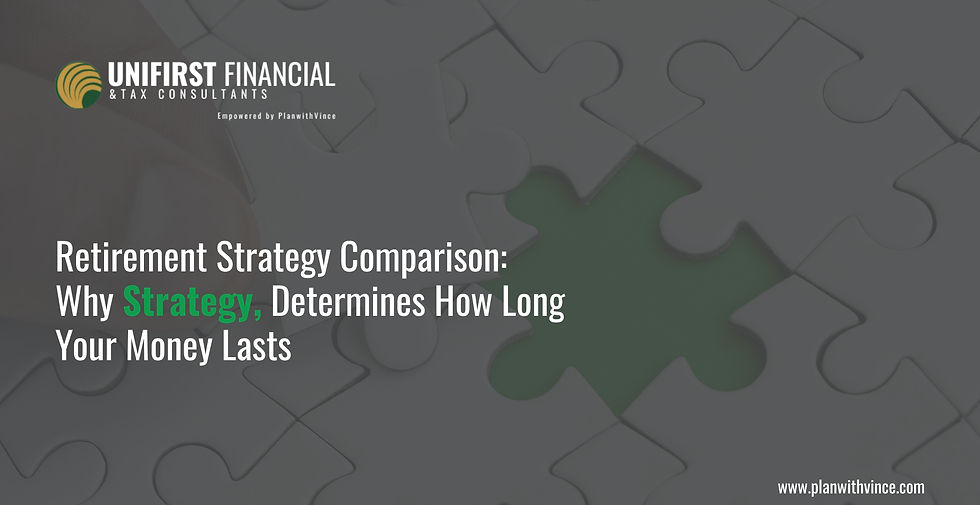Retirement Strategy Comparison. Why Strategy Determines How Long Your Money Lasts.
- Vincent Anthony Abu

- May 25
- 5 min read
Updated: Aug 2
Why Strategy Determines How Long Your Money Lasts

In 2024, three lifelong friends—John, Lisa, and Carlos—retired after decades of working in healthcare. Each walked away with $800,000 saved for retirement, planning to collect Social Security at age 66. Their lifestyle goals were modest but meaningful: enjoy the early retirement years with $40,000 per year, then settle into a slower rhythm at $25,000 annually after age 75.
They had similar plans—but their outcomes couldn’t have been more different. And what made the difference wasn’t luck or effort. It was strategy. What follows isn’t just a story—it’s a realistic projection using historical market data from 2000 to 2024.
Retirement Strategy Comparison for John, Lisa, and Carlos

John – The 401(k) Traditionalist
What happens when three people retire with the same amount—but different strategies?
John followed the standard playbook. He parked his retirement savings in a traditional 401(k) tied to the S&P 500. He felt confident that time and averages would work in his favor. He’d seen downturns before—and recoveries too.
In late 2024, the S&P dropped over 10% due to rising interest rates and geopolitical tension. In 2025, it slid another 13%. By 2026, it was down again, echoing the early 2000s dot-com collapse. At the worst possible time, John was withdrawing from a shrinking account.
Factor in a 1.5% management fee and 30% tax on every withdrawal, and the damage compounded. Even with a strong recovery in the years that followed, John's balance never fully bounced back. His account hit zero in his early 80s.
That’s sequence of returns risk in action. It’s not just about what the market gives; it’s about when it gives it.
Lisa – The FIA Optimist
Real market data. Real tax rules. Real consequences.
Lisa took a more conservative approach. She chose a Fixed Indexed Annuity (FIA) linked to the S&P 500 with a 0% floor, a 9% cap, and 55% participation in market gains. Her money wasn’t directly in the market—so when it dropped, she didn’t lose any.
In 2024 and 2025, while John’s account plummeted, Lisa earned 0%. However, she lost nothing. During the recovery years, her FIA credited gains within the cap. She paid no fees, and taxes were only due on her credited interest.
The result? Her money lasted. Not forever, but long enough. Her balance slowly declined over time, reaching a secure landing in her late 90s. She didn’t have to cut back, panic, or guess. Her income was protected—and predictable.
Lisa's strategy didn’t try to beat the market. It aimed to protect her lifestyle. And it succeeded.
Carlos – The MYGA Strategist
One retires broke. One coasts. One protects. Which would you be?
Carlos took the simplest route of all. He didn’t want the market’s upside—or its downside. He placed his savings in a Multi-Year Guaranteed Annuity (MYGA) earning a fixed 3.85% every year. No fees. No surprises. Just steady growth.
His withdrawals followed the same pattern: nothing at 65, then $40,000 a year from 66 to 75, then $25,000 a year afterward. He only paid taxes on interest—not on the total withdrawal amount.
Carlos's account thrived. There were no big wins, but also no losses. When John's account was gone, and Lisa's was slowly tapering, Carlos's balance remained strong—even into age 100. His strategy prioritized endurance over excitement.
Understanding Current Market Risks
Context Matters: Current Trends That Echo the Past
Retirees in 2024 are navigating familiar risks in a new form. Inflation, though off its peak, remains sticky in core categories (Bureau of Labor Statistics, April 2024). Interest rates remain elevated, with the Federal Reserve maintaining restrictive policy amid uncertainty (Federal Reserve, May 2024).
Markets continue to react to global unrest and AI-driven volatility. Analysts warn of tech-sector overconcentration and a cooling job market (Bloomberg, April 2024). Additionally, commercial real estate vacancy rates have reached historical highs. These factors raised concerns about bank exposure and urban economic recovery (WSJ, March 2024).
Much like the early 2000s, today’s economy is reshaped by a mix of technological disruption and monetary tightening. Coupled with record levels of government debt, ongoing labor shortages, and rising healthcare costs, the picture becomes clear: the next downturn may not be a matter of if, but when.
Protection Over Prediction
The Hypothetical Crisis: Why Today Mirrors the Past
The downturn they faced in 2024–2026 wasn’t unique. It echoed the early 2000s—a time defined by overvaluation, inflation pressure, and global uncertainty. This time, it was triggered by tech oversaturation, artificial intelligence recalibration, and tightening fiscal policy.
John might have fared well if the market had recovered earlier. But that’s the issue—timing is unpredictable. The market doesn’t align with your retirement plan. Lisa, with her FIA, would’ve likely thrived if returns were stronger and more consistent. Yet again, we cannot predict outcomes. If we could, we’d all be rich.
And the market bubble isn’t the only risk retirees face. Look at history:
The dot-com bust (2000–2002)
The Great Recession (2008–2009)
The COVID-19 crash (2020)
A potential post-AI correction or debt cycle reset, which is still looming
Each brought double-digit losses in just months.
That’s why protection matters. It’s not merely about growth; it’s about avoiding devastation. Lisa and Carlos didn’t win the market game—but they didn’t have to. They played a different game: preserve, protect, provide.
No one knows what the next crisis will be. However, we know there will be one. That’s reason enough to plan for it now.
The Importance of Strategic Planning
Retirement Strategy Comparison: Why the Details Matter
These scenarios were not imagined—they were calculated. Each outcome reflects how small decisions regarding timing, fees, taxation, and risk can create significant differences over 30+ years. Real market returns, real tax rules, real consequences.
It’s not just about predicting the future. Instead, it’s about preparing for it with strategies that prioritize protection, efficiency, and control.
So the question remains: If you had the tools to secure your income and protect your future from what history has already shown us, why would you leave it to chance?
Ready to Plan Smarter?
If this story made you think differently about your own future, don’t wait until it’s too late. Explore your options and get your free financial analysis report.
Whether you're a business owner looking to reduce taxes or an affluent individual wanting a safer retirement strategy—we’re here to help you take the next step with clarity and confidence.
Sources:
Bureau of Labor Statistics. "Consumer Price Index – April 2024." https://www.bls.gov/news.release/cpi.nr0.htm
Federal Reserve. "Monetary Policy Statement – May 2024." https://www.federalreserve.gov/monetarypolicy.htm
Bloomberg. "Tech Leads Market Volatility as Fed Guidance Weighs on Sentiment – April 2024." https://www.bloomberg.com/news/articles/2024-04-10/tech-leads-market-volatility-as-fed-guidance-weighs-on-sentiment
Wall Street Journal. "Commercial Real Estate Vacancy Surge Sparks Banking Concerns – March 2024." https://www.wsj.com/real-estate/commercial/commercial-real-estate-vacancy-surge-sparks-banking-concerns-2024










